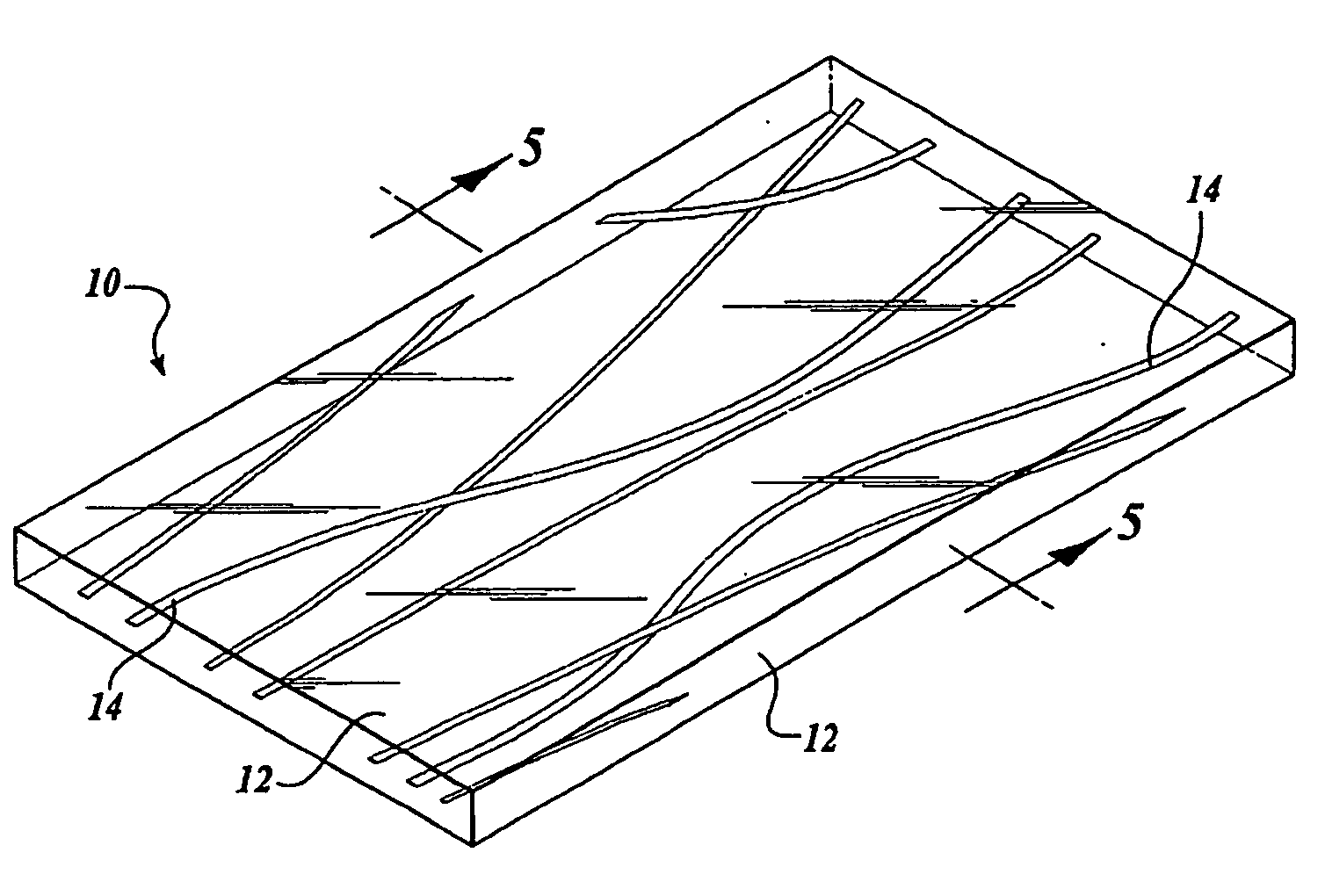Solid surface products
a technology of solid surface products and products, applied in the direction of synthetic resin layered products, picture frames, transportation and packaging, etc., can solve the problem of not being able to make such a solid surface produ
- Summary
- Abstract
- Description
- Claims
- Application Information
AI Technical Summary
Benefits of technology
Problems solved by technology
Method used
Image
Examples
example 1
[0054] In this example, the basic lay-up sandwich consists of three layers of the following starting materials: (1) a bottom sheet of the preferred polymethylmethacrylate material that is 0.060 inch thick, 48 inches wide, and 96 inches long; (2) a decorative textile fabric that is 58 inches wide and 102 inches long; and (3) a top sheet of the preferred polymethylmethacrylate that is 0.060 inch thick, 48 inches wide, and 96 inches long.
[0055] The final lay-up book is made as follows. A textured sheet of release paper that is 60 inches wide and 100 inches long is placed on a 0.060 inch thick aluminum caul plate and taped to the caul plate. The basic lay-up sandwich (described in the paragraph above) is placed on top of the textured sheet of release paper. The textured sheet of release paper will impart an aesthetically-pleasing texture to the outer surface of the bottom sheet of polymethylmethacrylate. The decorative textile fabric extending beyond the edges of polymethylmethacrylate...
example 2
[0060] In this example, the thickness of the product is 0.25 inch or greater. When fabricating products in a thickness of 0.25 inch or greater employing delicate decorative papers, fabrics, or organic materials, a first stage is necessary to encapsulate the decorative material within two thin sheets of 0.060 inch polymethylmethacrylate to prevent tearing of the decorative material caused by movement of the polymethylmethacrylate during pressing. The thinner sheets of polymethylmethacrylate will hold the decorative material in place with minimal movement during stage two. The two-stage process enables products to be made in thicker gauges with less “melt out.” Thus, maximum thickness is preserved. The goal is to transfer heat to the lay-up sandwich to melt the polymethylmethacrylate sheets together using the least amount of heat, pressure, and time.
[0061] In stage 1, a 0.12 inch intermediate product with 0.005 inch relief texture is made encapsulating the delicate decorative materia...
example 3
[0067] This is an example of the second embodiment of the invention illustrated by FIG. 4. In this example, the basic lay-up sandwich consists of three layers of the following starting materials: (1) a bottom layer 22 of the preferred polymethylmethacrylate material that is 0.060 inch thick, 48 inches wide, and 96 inches long; (2) a pre-textured intermediate layer 24 of the preferred polymethylmethacrylate material that is 0.060 inch thick, 48 inches wide, and 96 inches long; and, (3) a top layer 26 of the preferred polymethylmethacrylate that is 0.060 inch thick, 48 inches wide, and 96 inches long. When making this product (which does not have a layer of decorative material), it is necessary to pre-texture both surfaces of the intermediate polymethylmethacrylate sheet 24 to allow air and gases to escape during the pressing / heating operation. If the surfaces of the polymethylmethacrylate sheet 24 is not pre-textured, air bubbles will be trapped within the product.
[0068] In stage 1,...
PUM
| Property | Measurement | Unit |
|---|---|---|
| Temperature | aaaaa | aaaaa |
| Temperature | aaaaa | aaaaa |
| Temperature | aaaaa | aaaaa |
Abstract
Description
Claims
Application Information
 Login to View More
Login to View More - R&D
- Intellectual Property
- Life Sciences
- Materials
- Tech Scout
- Unparalleled Data Quality
- Higher Quality Content
- 60% Fewer Hallucinations
Browse by: Latest US Patents, China's latest patents, Technical Efficacy Thesaurus, Application Domain, Technology Topic, Popular Technical Reports.
© 2025 PatSnap. All rights reserved.Legal|Privacy policy|Modern Slavery Act Transparency Statement|Sitemap|About US| Contact US: help@patsnap.com



